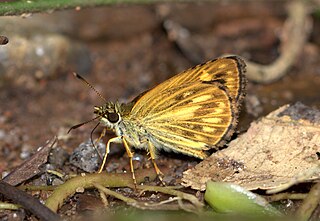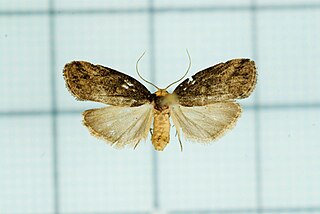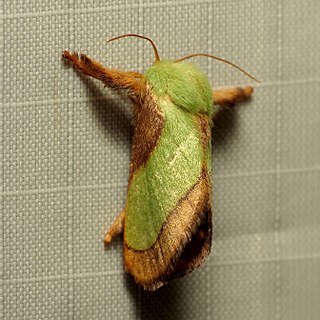Related Research Articles

Baracus vittatus, the hedge-hopper, is a butterfly belonging to the family Hesperiidae. It is found in India and Sri Lanka.

Sri Lanka Law College is a Law College on Hulftsdorp Street in Colombo, Sri Lanka, established in 1874 under the then-one-year-old Council of Legal Education in order to impart a formal legal education to those who wished to become advocates and proctors in Ceylon. The main building of the college was constructed in 1911.

Eugoa is a genus in the family Erebidae, subfamily Arctiinae. The genus was erected by Francis Walker in 1858. They are found in India, Sri Lanka, Myanmar and Borneo.

Parasa is a genus of moths of the family Limacodidae. It was described by Frederic Moore in 1860.
Pseudohemihyalea is a genus of moths in the family Erebidae described by Régo Barros in 1956. While the caterpillars of most species of Pseudohemihyalea feed on broad-leaved trees, the P. ambigua group has larvae that feed on conifers. Their forewing coloration has accordingly evolved to light-and-dark lengthwise striping, giving better camouflage among the slim needles of the host plants. In this, they seem to be convergent to certain geometer moths, such as Caripeta piniata or Sabulodes niveostriata.
Haimbachia is a genus of moths of the family Crambidae.

Sufetula is a genus of moths of the family Crambidae.
Lycaugesia is a genus of moths of the family Noctuidae. The genus was erected by Paul Dognin in 1910.

Ozarba is a genus of moths of the family Noctuidae. The genus was erected by Francis Walker in 1865.

Parasa lepida, the nettle caterpillar or blue-striped nettle grub, is a moth of the family Limacodidae that was described by Pieter Cramer in 1799. It is a native minor pest found in the Indo-Malayan region, including India, Sri Lanka, Vietnam, Malaysia and Indonesia. It is an introduced pest to urban trees in western Japan.
P. lepida may refer to:

Coenodomus is a genus of snout moths. It was described by Walsingham in 1888, and is known from India, Papua New Guinea, Bhutan, the Philippines, the United States, Indonesia, China, and Sri Lanka.
Migoplastis alba is a moth of the subfamily Arctiinae first described by Frederic Moore in 1877. It is found in Sri Lanka.

Packardia is a genus of moths in the family Limacodidae.
Wellesca Pollock Allen Dyar was an American educator and an early adherent to Baháʼí Faith in the United States. She was at the center of a Washington, D. C. society scandal in 1916.

Parasa chloris, the smaller parasa, is a species of slug caterpillar moth in the family Limacodidae.

Parasa bicolor, the green rice moth, is a moth of the family Limacodidae. The species was first described by Francis Walker in 1855. It is found in Sri Lanka, India, Nepal, Pakistan, Myanmar, Laos, Taiwan, Vietnam, Malaysia, Java, China and Taiwan.
Parasa hilaris is a moth of the family Limacodidae first described by Edward Meyrick in 1913. It is found in Sri Lanka and India.
Parasa similis is a moth of the family Limacodidae first described by Felder in 1874. It is found in Sri Lanka.
References
- ↑ "Species Details: Parasa hampsoni Dyar, 1894". Catalogue of Life. Retrieved 29 June 2018.
- ↑ Koçak, Ahmet Ömer; Kemal, Muhabbet (20 February 2012). "Preliminary list of the Lepidoptera of Sri Lanka". Cesa News. Centre for Entomological Studies Ankara (79): 1–57 – via Academia.